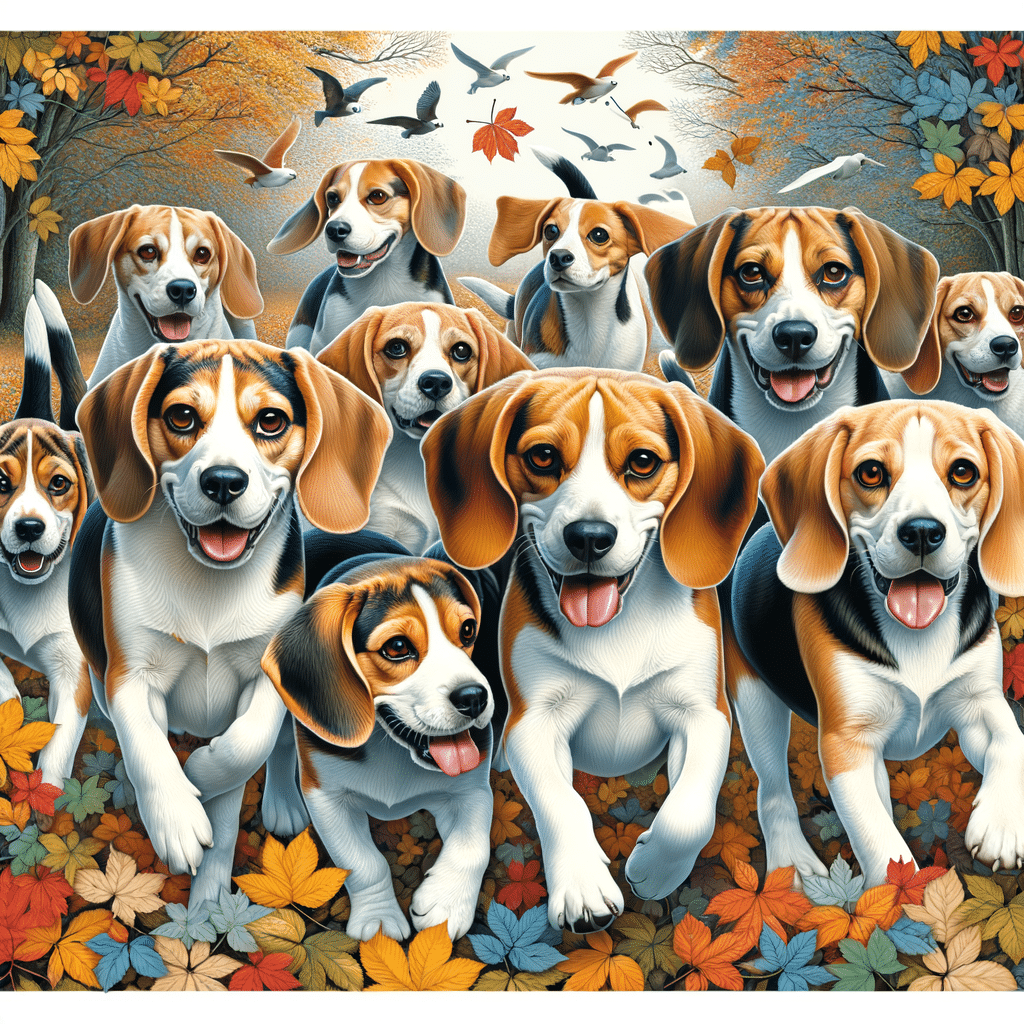The pocket beagle, a miniature version of the well-known beagle dog, is full of charm and personality. Standing at 7 to 12 inches tall and weighing between 7 and 15 pounds, this compact breed mirrors its larger counterpart in appearance and instinctual behavior. As with any breed, understanding the pocket beagle’s origin, overall disposition, and the specific care required is essential for would-be owners to ensure a harmonious match between the dog and their lifestyle.
In This Article
From a historical vantage point, the pocket beagle shares its lineage with the standard beagle, a breed renowned for its hunting prowess and keen sense of smell. Despite their size, pocket beagles are still alert and possess keen hunting instincts. However, they are predominantly companion dogs in modern times. They are developed by careful breeding, sometimes involving smaller breeds or the selection of smaller specimens from litters, and provide an endearing blend of playfulness, intelligence, and affection for families.
Highlights
- Pocket beagles are a smaller version of the beagle with a playful and affectionate nature.
- They require specific care tailored to their size and have a solid instinctual background.
- Prospective owners should seek reputable breeders or consider adoption to find a pocket beagle.
Breed Overview
The pocket beagle is a tinier version of the standard beagle with distinctive traits and a wealthy background. This section discusses their historical roots, physical characteristics, and recognition by breed registries.
History and Development
Originating from England, the pocket beagle’s ancestry can be traced back to the 13th century. They were reputedly bred for hunting small game. They were favorites of royal families, including Queen Elizabeth I, who kept these miniature hounds for hunting. They were sometimes called “Glove Beagles” because they were small enough to fit in a gloved hand.
While the original pocket beagle fell out of favor and ceased to exist as a separate breed, modern efforts to revive the breed led to the creation of the Queen Elizabeth pocket beagle. This miniaturized version retains many of the standard breed characteristics.
Size and Appearance
The pocket beagle is notably smaller than its Standard Beagle counterpart. Their appearance is characterized by:
- Height: Up to 12 inches at the shoulder
- Weight: 15 to 18 pounds
- Coat Color: Varies, including tricolor, black and tan, red, white and tan, brown and white, lemon and white
They possess the iconic beagle head shape, with expressive eyes and long, wide ears that hang around their head.
Breed Recognition
While the pocket beagle is a smaller variant of the standard beagle, it is not currently recognized by the American Kennel Club (AKC) as a separate breed. The AKC does recognize the standard beagle, which shares many traits with its smaller counterpart.
Temperament and Behavior
The pocket beagle is a breed characterized by its friendly behavior and adaptable temperament, making it a preferred companion dog for families. This dog breed exhibits enthusiasm and intelligence, which calls for mindful behavioral training and regular exercise.
Personality Traits
Pocket beagles are noted for their affectionate and friendly nature. They are energetic and playful, thriving in a family environment where they can be involved in daily activities. Despite their size, they possess the same keen scent receptors as their larger beagle counterparts, often showcasing a pronounced prey drive, which makes them curious and eager to explore their surroundings.
- Intelligence: Brilliant and responsive to training.
- Family-friendly: Excellent with children, making them ideal family pets.
- Energetic: Requires adequate exercise to manage energy levels.
- Companionship: Do not like to be left alone; they are social, preferring company.
Behavioral Training
Practical training is crucial for pocket beagles, as it harnesses their intelligence and manages their sometimes stubborn streak. Consistent training helps mitigate unwanted behaviors such as barking and chasing due to their prey drive.
- Positive reinforcement: Best approach for training.
- Exercise: Regular physical activity is essential for managing energy and behavior.
- Mental stimulation: To prevent boredom, provide activities that engage their senses like scent work.
- Socialization: Early and ongoing socialization helps pocket beagles get along with other pets.
- Independence: While they enjoy companionship, independence should also be encouraged through training to mitigate separation anxiety.
Training your miniature beagle requires patience and consistency, resulting in a well-mannered and delightful family pet.
Health and Care
When considering the well-being of a pocket beagle, it is essential to be aware of their specific health challenges and care requirements. Proper grooming, balanced nutrition, and suitable living conditions are fundamental to their health and happiness.
Common Health Issues
Pocket beagles are predisposed to specific health issues that prospective and current owners should monitor. These can include:
- Patellar luxation: A condition where the kneecap dislocates.
- Epilepsy: Causing seizures that can be managed under veterinary supervision.
- Hypothyroidism: Affecting metabolism and overall health.
- Ear infections: Frequent in pocket beagles due to their floppy ears, which can trap moisture.
They can also carry a dwarfism gene, which might cause skeletal problems. A reputable breeder should test for these disorders to ensure they are not passed on.
Grooming and Diet
The grooming and dietary needs of pocket beagles are straightforward but crucial:
- Grooming: Their short coat experiences moderate shedding. Routine brushing once a week helps maintain coat health and reduces shedding.
- Ears: Regular checking and cleaning are essential to prevent ear infections.
- Teeth: Brushing their teeth or using dental chews can help prevent dental issues.
As for diet, these hounds require balanced nutrition high in protein to support their energy levels. Overfeeding should be avoided to prevent obesity.
Exercise and Living Conditions
Pocket beagles possess high energy levels, requiring daily exercise to stay fit and happy:
- Regular walks and playtime help maintain a healthy weight and prevent behavior problems.
- They adapt well to apartment living as long as their exercise needs are met.
These popular dog breeds are social animals and thrive in environments where they have company and space to explore with their keen nose. Proper attention to their physical and emotional needs ensures a quality life, contributing to a healthy lifespan of 10-15 years.
Adoption and Breeders
When considering the addition of a pocket beagle to the family, potential adopters should prioritize finding reputable breeders and learning about healthy breeding practices. A balance between the excitement of finding a pocket beagle puppy and the commitment to support responsible breeding is crucial.
Finding a Pocket Beagle
Pocket Beagle Puppies: Typically, pricing for pocket beagle puppies ranges from $500 to $2,500. Potential owners should be prepared for this financial commitment. Searching for a pocket beagle involves considering various avenues:
- Reputable Breeders: Affiliated with communities such as the Olde English Pocket Beagle Registry, these breeders adhere to strict breeding practices.
- Rescue Organizations: Occasionally, pocket beagles are available for adoption through rescue groups, presenting an alternative to purchasing a puppy.
In both instances, due diligence is critical to ensure the health and socialization of the pocket beagle.
Responsible Breeding
Ethical breeders prioritize the well-being of their pocket beagles from whelping to weaning and often provide socialization opportunities for puppies before adoption.
- Health Checks: Reputable breeders conduct thorough health checks to screen for conditions such as dwarfism, which can affect the pocket beagle breed.
- Registry Affiliation: An association with a recognized registry, like the Olde English Pocket Beagle Registry, signifies a breeder’s dedication to preserving the breed’s characteristics and health standards.
Breeders and adoption agencies should provide transparency regarding the puppies’ temperaments, health lineage, and socialization experiences.
Frequently Asked Questions
In considering the adoption of a pocket beagle, prospective owners frequently inquire about costs, temperament, sourcing reputable breeders, compatibility with children, and exercise needs.
What should I consider before adopting a pocket beagle?
Consider their living space, as pocket beagles can adapt well to smaller spaces but still need adequate room for play. Additionally, potential owners should assess their ability to meet the daily exercise and companionship needs of these social and energetic tiny dogs.
How much typically does a pocket beagle cost?
A pocket beagle typically costs between $500 and $2,500. However, prices fluctuate based on the breeder’s reputation, the beagle breed’s lineage, and the area where you’re purchasing the dog.
What are the characteristics of a pocket beagle’s temperament?
Pocket beagles are known for being playful, affectionate, and curious. They are intelligent dogs that may display a blend of eagerness to please and stubbornness, requiring patience and consistent training.
How can I find a responsible pocket beagle breeder?
To find a responsible pocket beagle breeder, one should research breeders who perform health screenings on their dogs, provide a clean and stimulating environment, and are transparent about the breeding practices and lineage of the dogs.
Are pocket beagles suitable for families with children?
Pocket beagles are suitable for families with children due to their compact size and friendly nature. They can be good companions for kids, but interactions should always be supervised to ensure safe play for the child and the dog.
What are the exercise requirements for a pocket beagle?
Pocket beagles need regular exercise to maintain their health and manage their energy levels. Daily routines should include walks, playtime, and mental stimulation to satisfy these active dogs.






